MERCEDES-BENZ SL CLASS 2018 Owners Manual
Manufacturer: MERCEDES-BENZ, Model Year: 2018, Model line: SL CLASS, Model: MERCEDES-BENZ SL CLASS 2018Pages: 298, PDF Size: 4.54 MB
Page 281 of 298
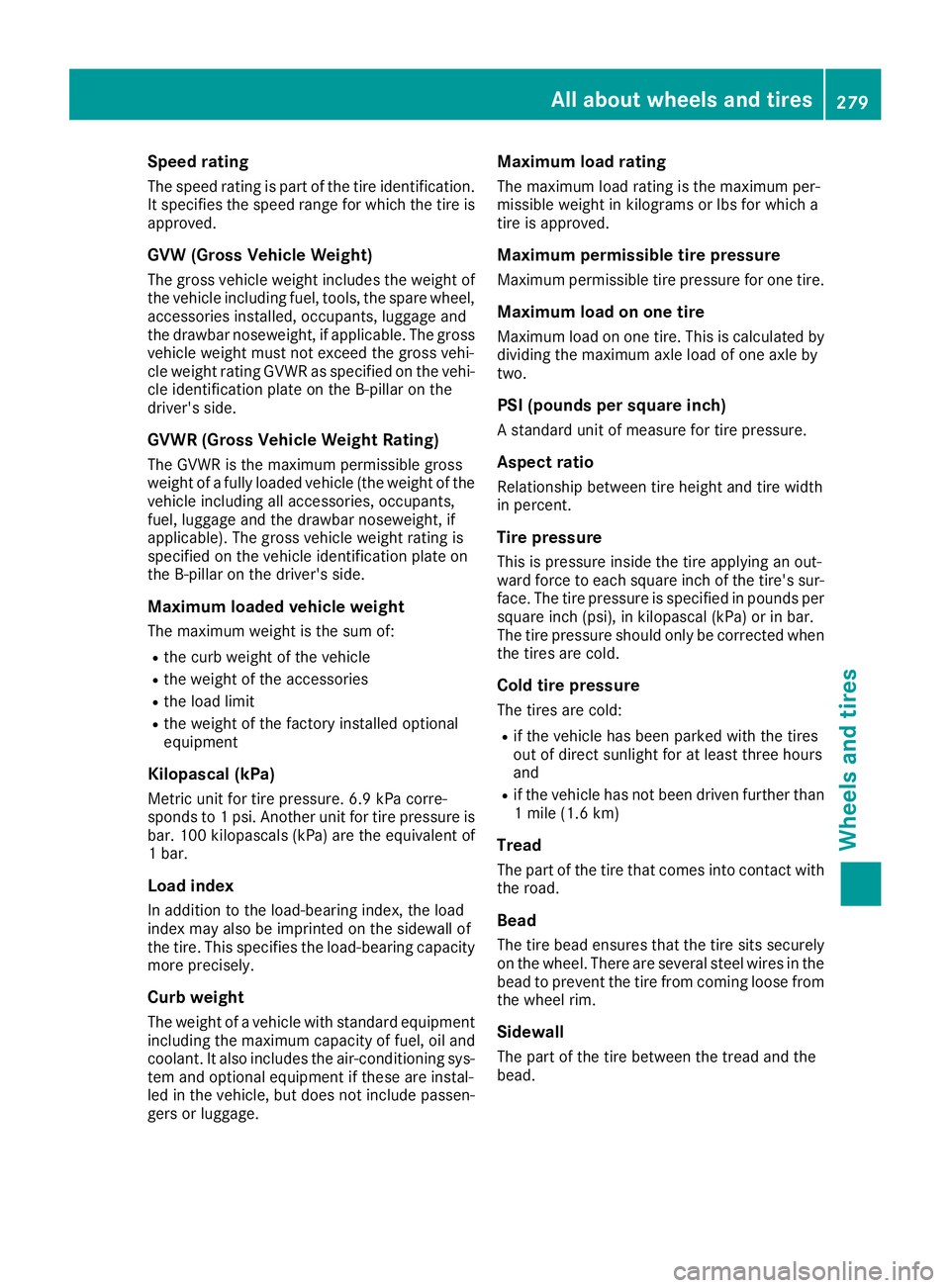
Speed rating The speed rating is part of the tire identification.
It specifies the speed range for which the tire is
approved.
GVW (Gross Vehicle Weight) The gross vehicle weight includes the weight of
the vehicle including fuel, tools, the spare wheel,
accessories installed, occupants, luggage and
the drawbar noseweight, if applicable. The gross
vehicle weight must not exceed the gross vehi-
cle weight rating GVWR as specified on the vehi-
cle identification plate on the B-pillar on the
driver's side.
GVWR (Gross Vehicle Weight Rating) The GVWR is the maximum permissible gross
weight of af ully loaded vehicle (the weight of the
vehicle including all accessories, occupants,
fuel, luggage and the drawbar noseweight, if
applicable). The gross vehicle weight rating is
specified on the vehicle identification plate on
the B-pillar on the driver's side.
Maximu ml oaded vehicle weightThe maximum weight is the sum of: R
the curb weight of the vehicle R
the weight of the accessories R
the load limit R
the weight of the factory installed optional
equipment
Kilopascal (kPa) Metric unit for tire pressure. 6.9 kPa corre-
sponds to 1p si. Another unit for tire pressure is
bar. 100 kilopascals (kPa) are the equivalent of
1b ar.
Load index
In addition to the load-bearing index, the load
index may also be imprinted on the sidewal lo f
the tire. This specifies the load-bearing capacity
more precisely.
Curb weight
The weight of av ehicle with standard equipment
including the maximum capacity of fuel, oil and
coolant. It also includes the air-conditioning sys-
tem and optional equipment if these are instal-
led in the vehicle, but does not include passen-
gers or luggage. Maximu ml oad ratingThe maximum load rating is the maximum per-
missible weight in kilograms or lbs for which a
tire is approved.
Maximu mp ermissible tire pressureMaximum permissible tire pressure for one tire.
Maximu ml oad on one tireMaximum load on one tire. This is calculated by
dividing the maximum axle load of one axle by
two.
PSI (pounds per squar ei nch)As tandard unit of measure for tire pressure.
Aspect ratio Relationship between tire height and tire width
in percent.
Tire pressure This is pressure inside the tire applying an out-
ward force to each square inch of the tire's sur-
face. The tire pressure is specified in pounds per
square inch (psi), in kilopascal (kPa) or in bar.
The tire pressure should only be corrected when
the tires are cold.
Cold tire pressure The tires are cold: R
if the vehicle has been parked with the tires
out of direct sunlight for at least three hours
and R
if the vehicle has not been driven further than
1m ile (1.6 km)
Tread
The part of the tire that comes into contact with
the road.
Bead
The tire bead ensures that the tire sits securely
on the wheel. There are several steel wires in the
bead to prevent the tire from coming loose from
the wheel rim.
Sidewall
The part of the tire between the tread and the
bead.All about wheel sa nd tires 279
Wheels and tires Z
Page 282 of 298
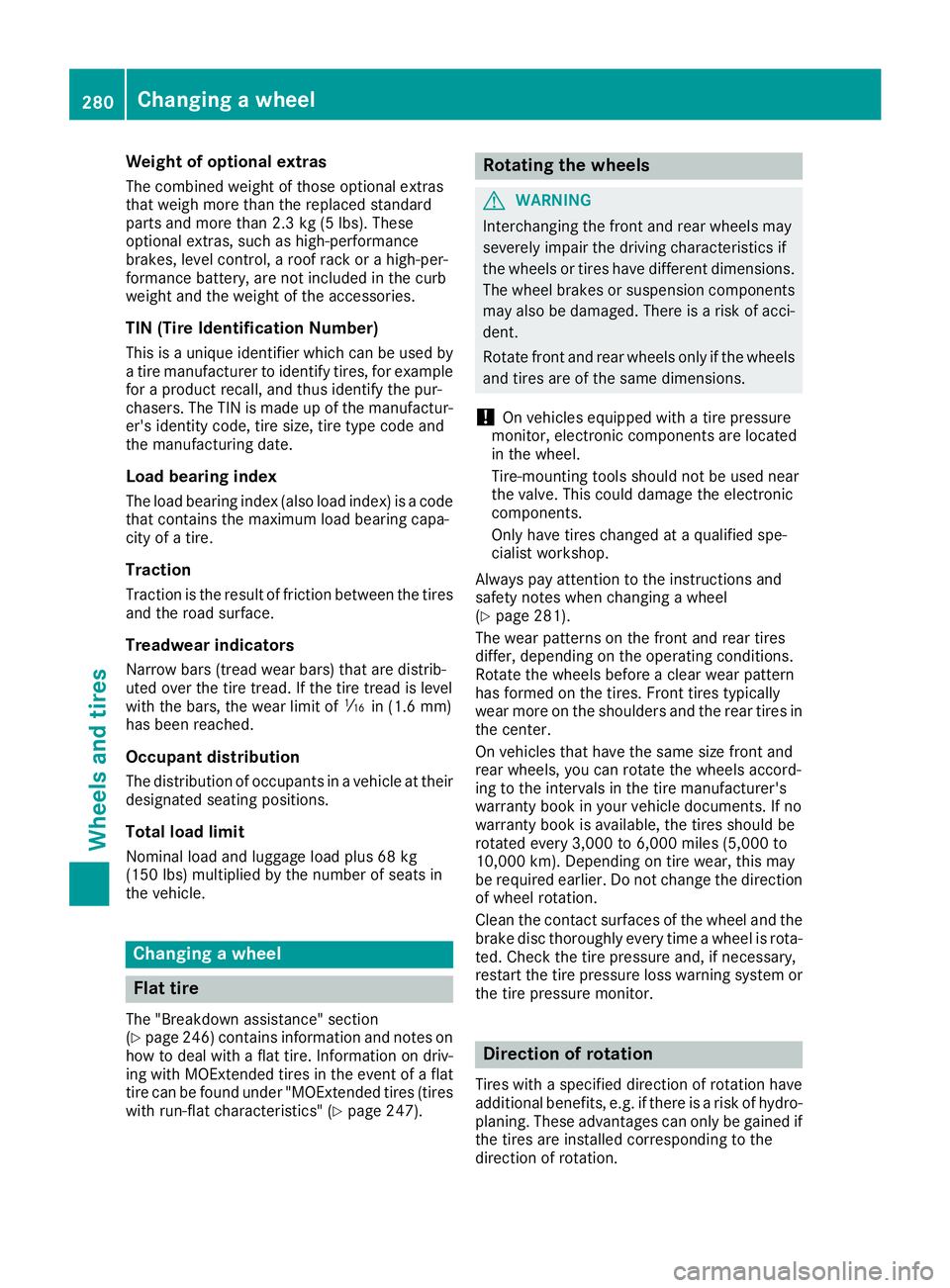
Weight of optional extras The combined weight of those optiona le xtras
that weigh more than the replaced standard
parts and more than 2.3 kg (5 lbs) .T hese
optiona le xtras, such as high-performance
brakes ,l eve lc ontrol, ar oof rack or ah igh-per-
formance battery ,a re not included in the curb
weight and the weight of the accessories.
TIN (Tire Identification Number) This is au nique identifier which can be use db y
at ire manufacturer to identify tires, for example
for ap roduct recall, and thus identify the pur-
chasers. The TIN is made up of the manufactur-
er's identity code, tire size, tire type code and
the manufacturing date.
Load bearin gi ndexThe loa db earing index (also loa di ndex) is ac ode
that contains the maximu ml oa db earing capa-
city of at ire.
Traction Tractio nist he result of friction between the tires
and the road surface.
Treadwear indicators Narrow bars (tread wea rb ars )t hat are distrib-
uted over the tire tread. If the tire tread is level
with the bars ,t he wea rl imi to f �
Page 283 of 298
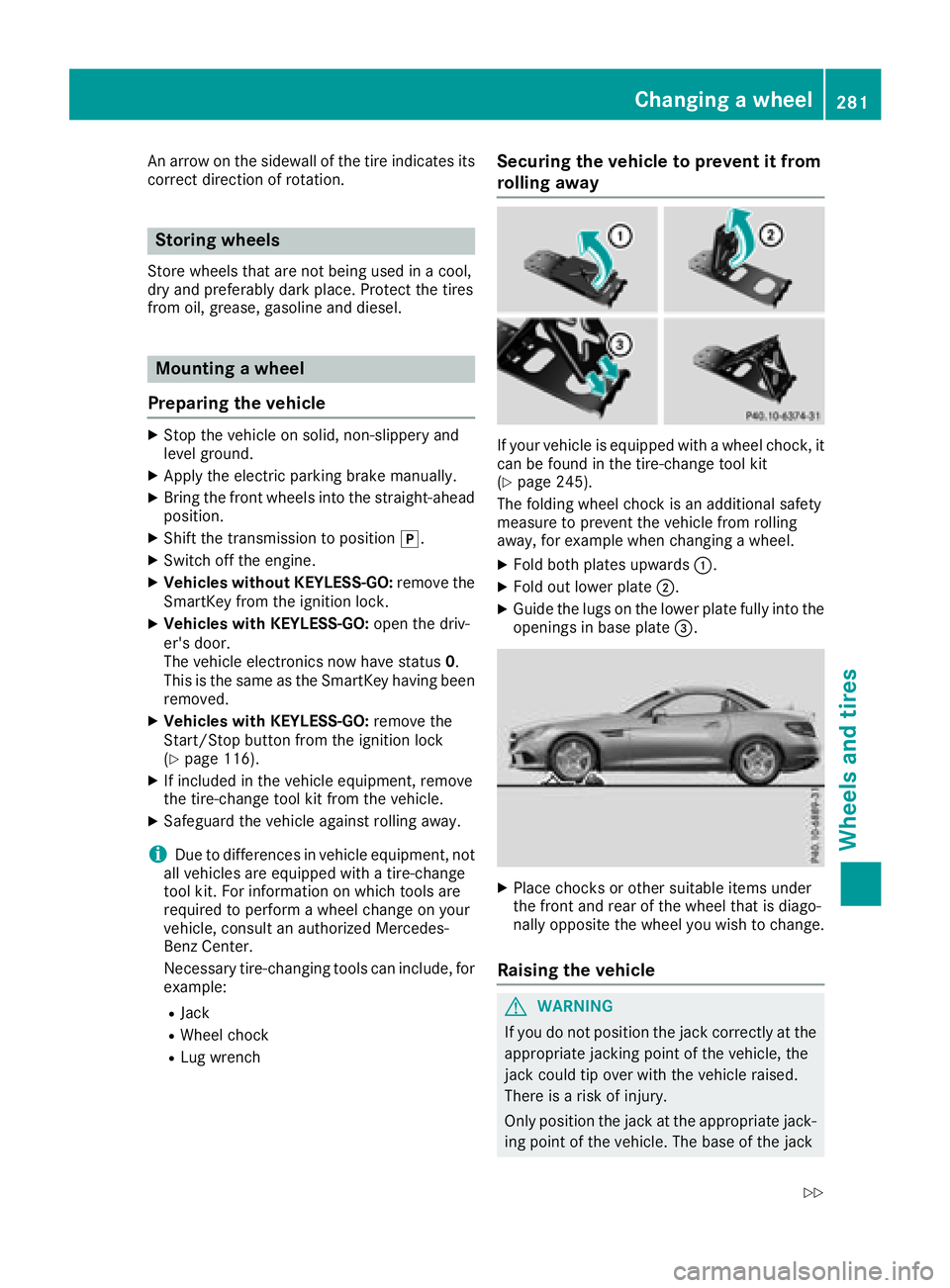
An arrow on the sidewall of the tire indicates its
correct direction of rotation.
Storin gw heelsStore wheels tha ta re not being used in ac ool,
dry and preferably dark place .P rotect the tires
from oil, grease, gasoline and diesel.
Mounting aw heel
Preparin gt he vehicleX
Stop the vehicl eons olid ,n on-slippery and
level ground. X
Apply the electri cp ar king brake manually.X
Bring the front wheels into the straight-ahead
position. X
Shift the transmission to position �] .X
Switch off the engine. X
Vehicles withou tK EYLESS -GO: remove the
SmartKe yf rom the ignition lock.X
Vehicles with KEYLESS-GO: open the driv-
er' sd oo r.
The vehicl ee le ctronics now have status 0 .
Thi sist he same as the SmartKe yh av ing been
removed. X
Vehicles with KEYLESS-GO: remove the
Start/Stop button from the ignition lock
( Y
page 116). X
If included in the vehicl ee quipment ,r emove
the tire-change tool kit from the vehicle. X
Safeguar dt he vehicl ea gain st rolling away.
i Due to difference sinv ehicl ee quipment ,n ot
al lv ehicles ar ee quippe dw it hat ire-change
tool kit. For informatio nonw hi ch tool sa re
required to perfor maw heel change on your
vehicle, consult an authorize dM ercedes-
Benz Center.
Necessary tire-changing tool sc an include, for
example: R
Jack R
Wheel chock R
Lu gw rench Securin gt he vehicle to preven titf rom
rolling away
If your vehicl eise quippe dw it haw heel chock, it
can be found in the tire-change tool kit
( Y
page 245).
The folding whee lc hoc ki sana ddit ional safety
measure to prevent the vehicl ef rom rolling
away ,f or exampl ew he nc hanging aw heel .X
Fol db ot hp la te su pwar ds �C .X
Fol do ut lowe rp la te �D .X
Guid et he lugs on the lowe rp la te full yi nto the
openings in base plate �
Page 284 of 298
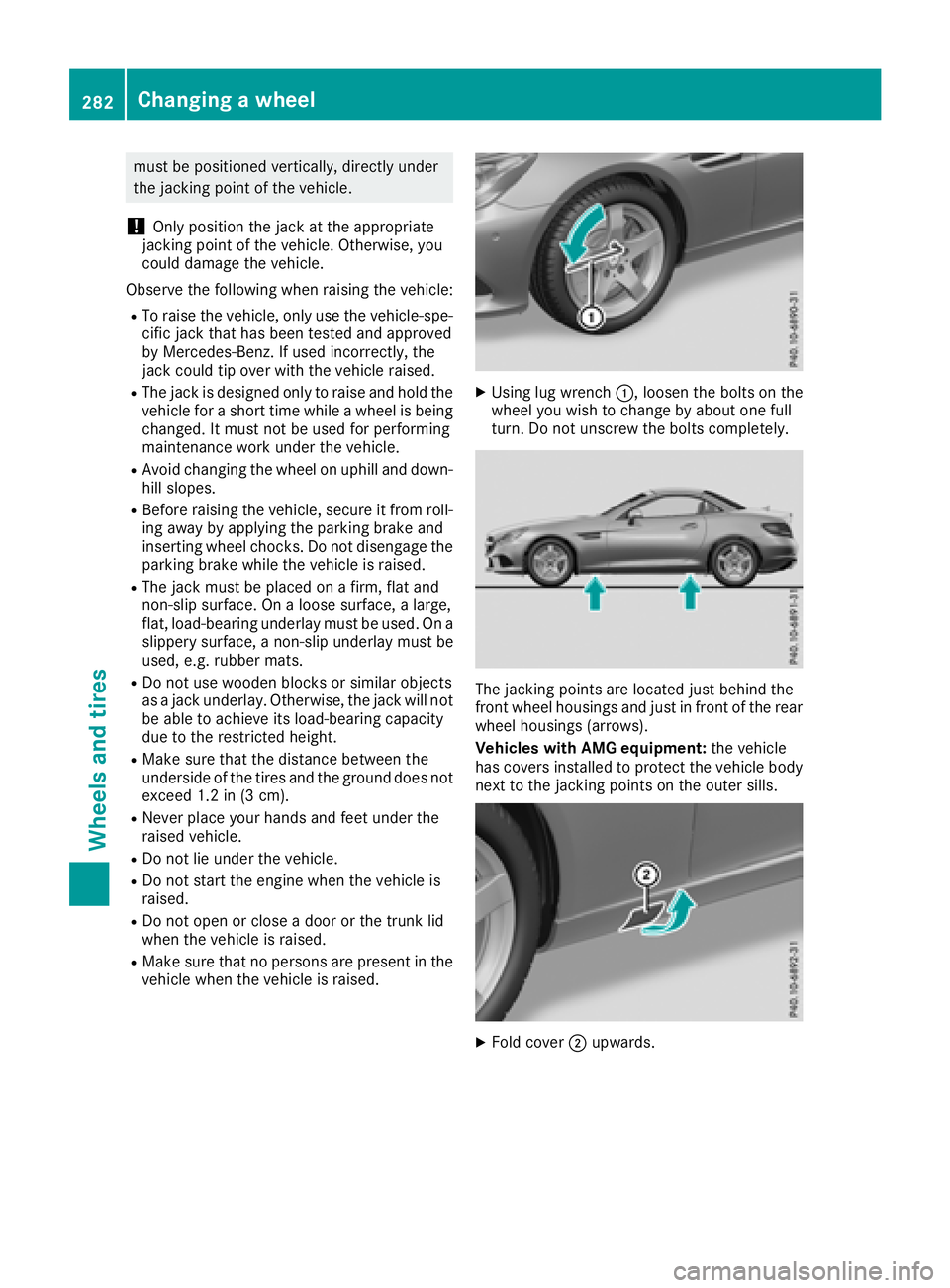
must be positioned vertically, directly under
the jacking point of the vehicle.
! Only position the jack at the appropriate
jacking point of the vehicle. Otherwise, you
could damage the vehicle.
Observe the following when raising the vehicle: R
To rais et he vehicle, only use the vehicle-spe-
cific jack that has been tested and approved
by Mercedes-Benz. If used incorrectly, the
jack could tip over with the vehicl er aised.R
The jack is designed only to rais ea nd hold the
vehicl ef or as hort time while aw hee lisb eing
changed. It must not be used for performing
maintenance work under the vehicle. R
Avoid changing the whee lonu phill and down-
hill slopes. R
Before raising the vehicle, secure it from roll-
ing awa ybya pplying the parking brake and
inserting whee lc hocks. Do not disengage the
parking brake whil et he vehicl eisr aised.R
The jack must be placed on af irm, flat and
non-slip surface. On al oose surface, al arge,
flat, load-bearing underlay must be used .Ona
slippery surface, an on-slip underlay must be
used ,e .g. rubber mats.R
Do not use wooden blocks or similar objects
as aj ack underlay .O therwise, the jack wil ln ot
be abl etoa chieve its load-bearing capacity
due to the restricted height. R
Make sure that the distance betwee nt he
underside of the tires and the ground does not
exceed 1.2 in (3 cm). R
Never place you rh ands and feet under the
raised vehicle. R
Do not lie under the vehicle. R
Do not start the engine when the vehicl ei s
raised. R
Do not open or close ad oor or the trunk lid
when the vehicl eisr aised.R
Make sure that no persons are present in the
vehicl ew hen the vehicl eisr aised. X
Using lug wrench �C ,l oose nt he bolts on the
whee ly ou wish to change by abou to ne full
turn. Do not unscrew the bolts completely.
The jacking points are located just behind the
front whee lh ousings and just in front of the rear
whee lh ousings (arrows).
Vehicles with AMG equipment: the vehicle
has covers installed to protect the vehicl eb ody
next to the jacking points on the outer sills.
X
Fold cover �D upwards.282
Changing aw heel
Wheel sa nd tires
Page 285 of 298
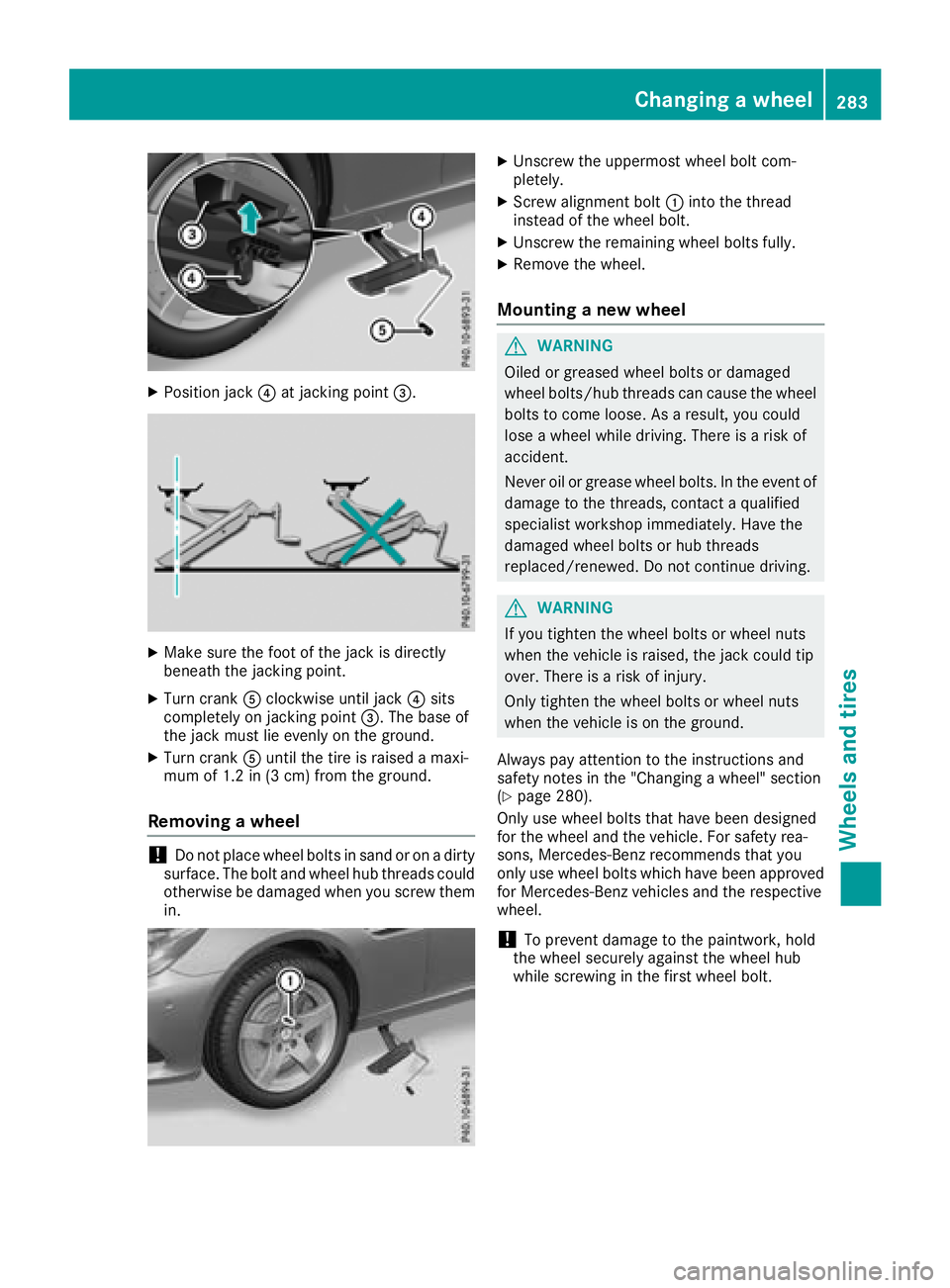
X
Position jack �
Page 286 of 298
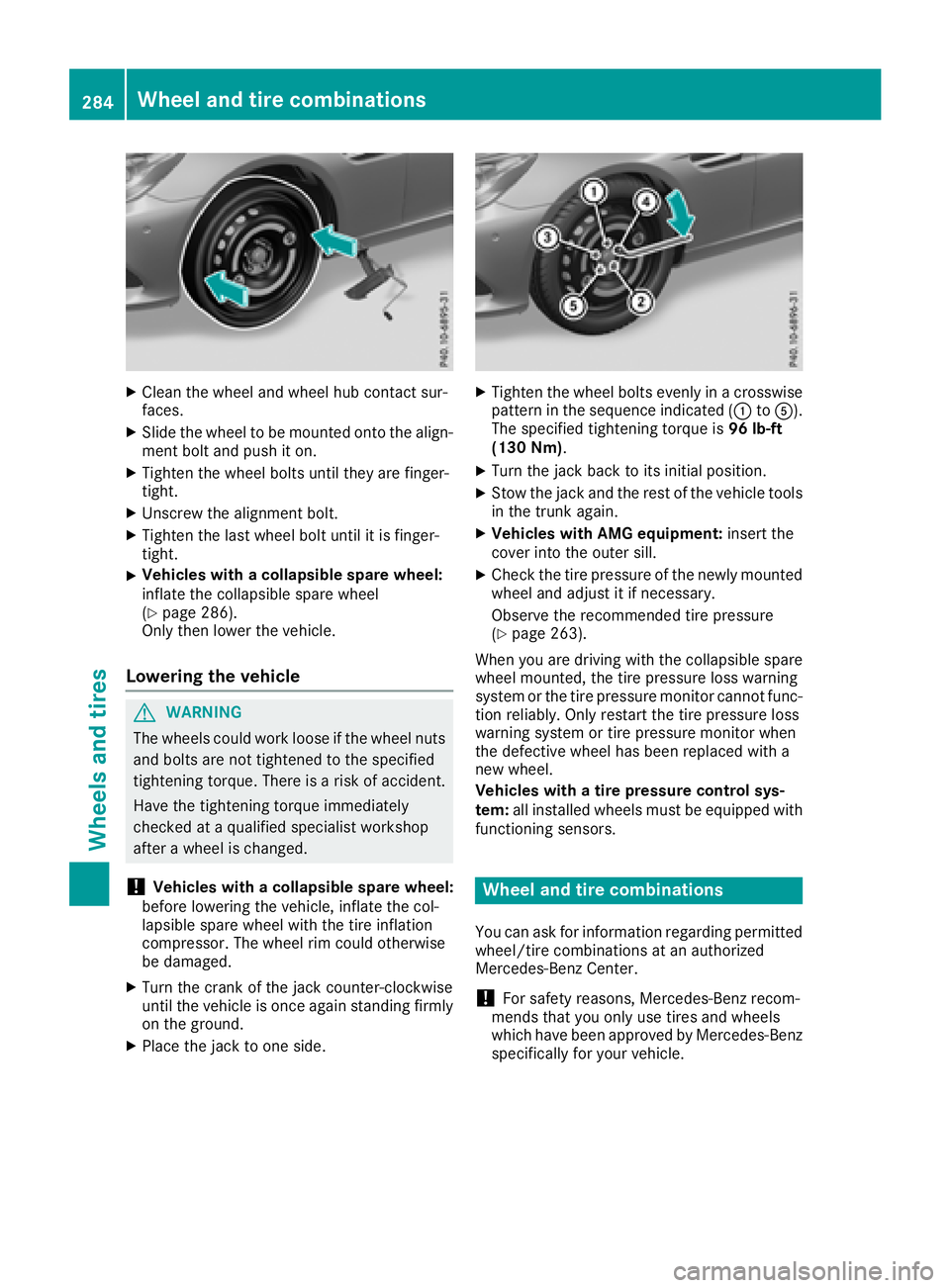
X
Clean th ew heel and wheel hub contact sur-
faces. X
Slid et he wheel to be mounte do nt ot he align-
men tb olt and push it on.X
Tighte nt he wheel bolt su nt il they are finger-
tight. X
Unscrew th ea lignmen tb olt.X
Tighte nt he last wheel bolt unt il it is finger-
tight. X
Vehicles with ac ollapsible spa re wheel:
inflate th ec ol lapsi ble spar ew heel
( Y
page 286).
On ly then lower th ev eh icle .
Lowering th ev ehicle
G WAR NING
The wheel sc ou ld work loos eift he wheel nuts
and bolt sa re no tt ig htened to th es pec ifie d
tightening torque. Ther eisar is kofa cc iden t.
Hav et he tightening torque immediately
checked at aq ualified spec ialist workshop
after aw heel is changed.
! Vehicles with ac ollapsible spa re wheel:
before lowering th ev eh icle ,i nflate th ec ol -
lapsible spar ew heel wit ht he tir ei nflation
compressor. The wheel rim could other wise
be damaged.X
Turn th ec ra nk of th ej ac kc ou nter-clock wise
unt il th ev eh icle is once again standing firmly
on th eg round.X
Plac et he jac ktoo ne side. X
Tighte nt he wheel bolt se venly in ac ro ss wise
pattern in th es equenc ei ndicated ( �C to �
Page 287 of 298
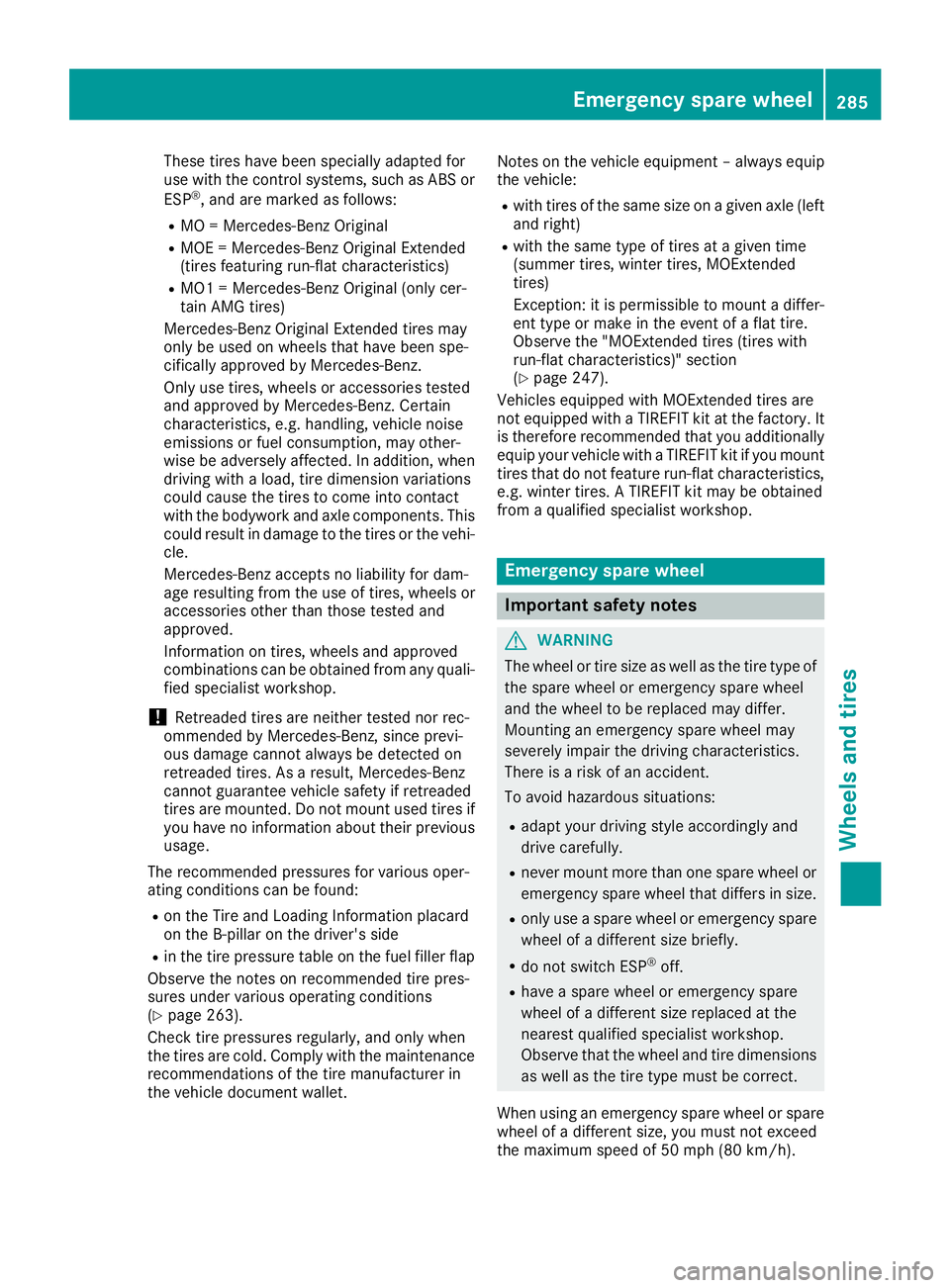
These tires have been specially adapted for
use with the control systems, such as ABS or
ESP ®
,a nd are marked as follows:R
MO = M ercedes-Benz OriginalR
MOE = M ercedes-Benz Original Extended
(tires featuring run-flat characteristics) R
MO1 = M ercedes-Benz Original (only cer-
tain AMG tires)
Mercedes-Benz Original Extended tires may
only be used on wheels that have been spe-
cifically approved by Mercedes-Benz.
Only use tires, wheels or accessories tested
and approved by Mercedes-Benz .C ertain
characteristics, e.g. handling, vehicle noise
emissions or fuel consumption, may other-
wise be adversely affected. In addition, when
driving with al oad, tire dimension variations
could cause the tires to come into contact
with the bodywork and axle components .T his
could result in damage to the tires or the vehi-
cle.
Mercedes-Benz accepts no liability for dam-
age resulting from the use of tires, wheels or
accessories other than those tested and
approved.
Information on tires, wheels and approved
combinations can be obtained from any quali-
fied specialist workshop.
! Retreaded tires are neither tested nor rec-
ommended by Mercedes-Benz ,s ince previ-
ous damage cannot alway sbed etected on
retreaded tires. As ar esult, Mercedes-Benz
cannot guarantee vehicle safety if retreaded
tires are mounted. Do not mount used tires if
you have no information about their previous
usage.
The recommended pressures for various oper-
ating conditions can be found: R
on the Tire and Loading Information placard
on the B-pillar on the driver's side R
in the tire pressure table on the fuel filler flap
Observe the notes on recommended tire pres-
sures under various operating conditions
( Y
page 263).
Check tire pressures regularly, and only when
the tires are cold. Comply with the maintenance
recommendations of the tire manufacturer in
the vehicle document wallet. Notes on the vehicle equipment –a lway se quip
the vehicle: R
with tires of the same size on ag iven axle (left
and right) R
with the same type of tires at ag iven time
(summer tires, winter tires, MOExtended
tires)
Exception: it is permissible to mount ad iffer-
ent type or make in the event of af lat tire.
Observe t he
"MOExtended tires (tires with
run-flat characteristics)" section
( Y
page 247).
Vehicles equipped with MOExtended tires are
not equipped with aT IREFIT kit at the factory. It
is therefor er ecommended that you additionally
equip your vehicle with aT IREFIT kit if you mount
tires that do not feature run-flat characteristics,
e.g. winter tires. AT IREFIT kit may be obtained
from aq ualified specialist workshop.
Emergency spar ew heel
Important safety notes
G WARNING
The wheel or tire size as well as the tire type of
the spare wheel or emergenc ys pare wheel
and the wheel to be replaced may differ.
Mountin gane mergenc ys pare wheel may
severely impair the driving characteristics.
There is ar isk of an accident.
To avoid hazardous situations: R
adapt your driving style accordingly and
drive carefully. R
never mount more than one spare wheel or
emergenc ys pare wheel that differs in size. R
only use as pare wheel or emergenc ys pare
wheel of ad ifferent size briefly. R
do not switch ESP ®
off.R
have as pare wheel or emergenc ys pare
wheel of ad ifferent size replaced at the
nearest qualified specialist workshop.
Observe that the wheel and tire dimensions
as well as the tire type must be correct.
When using an emergenc ys pare wheel or spare
wheel of ad ifferent size, you must not exceed
the maximum speed of 50 mph (80 km/h).Emergency spar ew heel 285
Wheels and tires Z
Page 288 of 298
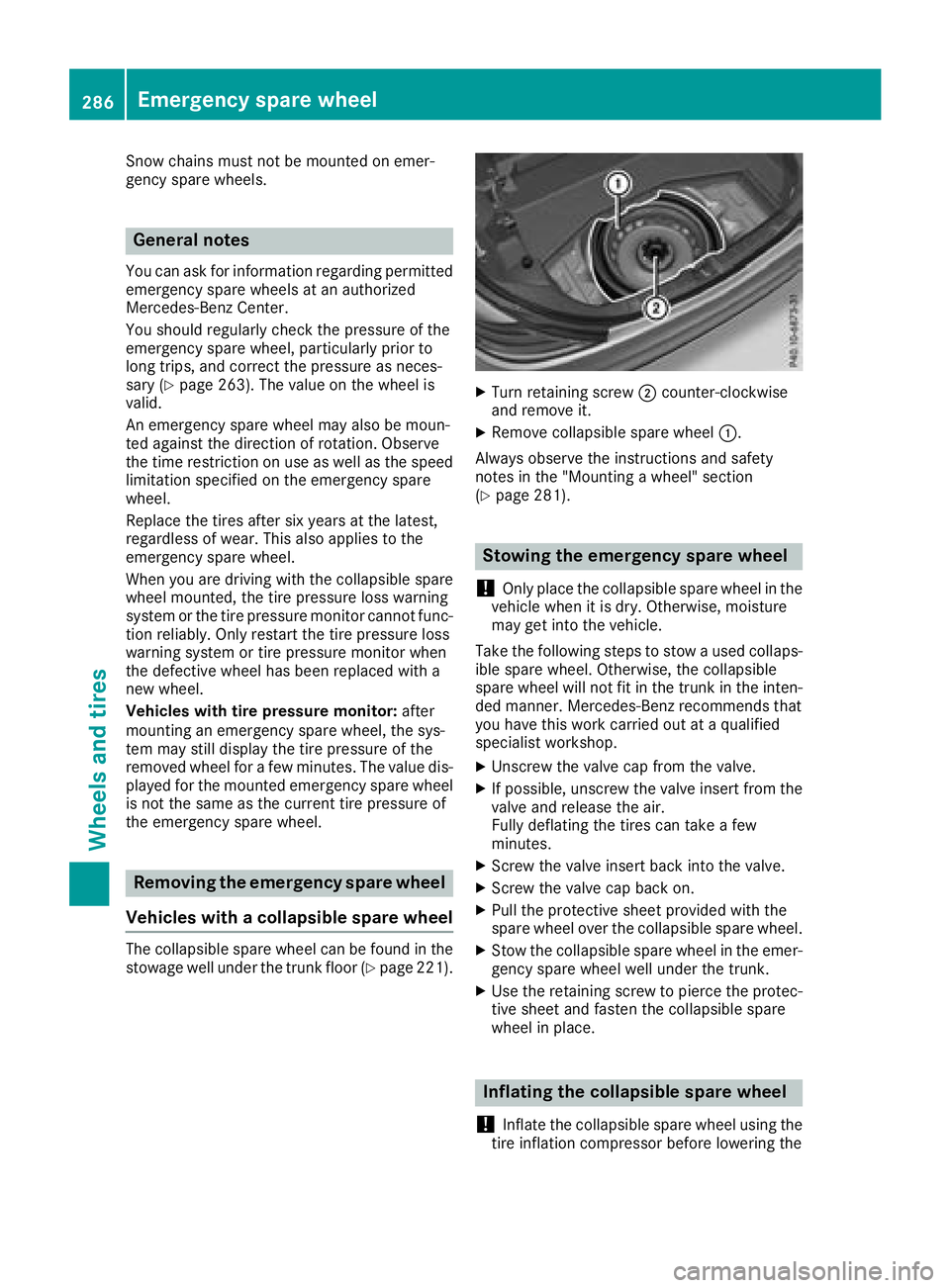
Snow chains mus tn ot be mounted on emer-
gency spare wheels.
General notes You can as kf or information regarding permitted
emergency spare wheel satana ut horized
Mercedes-Benz Center.
You shoul dr egularl yc heck the pressure of the
emergency spare wheel ,p ar ticularly prior to
long trips, and correct the pressure as neces-
sary ( Y
page 263). The value on the wheel is
valid.
An emergency spare wheel may also be moun-
ted against the direction of rotation. Observe
the time restriction on us easw el last he speed
limitation specified on the emergency spare
wheel.
Replace the tire sa fte rs ix years at the latest,
regardless of wear. Thi sa ls oa pplies to the
emergency spare wheel.
Whe ny ou are driving with the collapsibl es pare
wheel mounted, the tire pressure loss warning
system or the tire pressure monitor canno tf unc-
tion reliably. Only restart the tire pressure loss
warning system or tire pressure monitor when
the defectiv ew he el ha sb ee nr eplaced with a
new wheel.
Vehicles with tire pressure monitor: after
mounting an emergency spare wheel ,t he sys-
tem may stil ld is play the tire pressure of the
removed wheel for af ew minutes. The value dis-
played for the mounted emergency spare wheel
is not the same as the current tire pressure of
the emergency spare wheel.
Removin gt he emergenc ys pare wheel
Vehicles with ac olla psibl es pare wheelThe collapsibl es pare wheel can be found in the
stowag ew el lu nder the trunk floor ( Y
page 221). X
Turn retaining screw �D counter-clockwise
and remove it. X
Remove collapsibl es pare wheel �C .
Alway so bserve the instructions and safety
notes in the "Mounting aw he el "s ection
( Y
page 281).
Stowin gt he emergenc ys pare wheel
! Only place the collapsibl es pare wheel in the
vehicl ew he nitisd ry .O therwise, moisture
may get into the vehicle.
Take the following step stos tow au se dc ollaps-
ible spare wheel .O therwise, the collapsible
spare wheel will not fit in the trunk in the inten-
ded manner. Mercedes-Benz recommend st hat
yo uh av et his work carrie do ut at aq uali fied
specialist workshop. X
Unscre wt he valve cap from the valve. X
If possible ,u nscrew the valve insert from the
valve and release the air.
Fully deflating the tire sc an take af ew
minutes. X
Screw the valve insert back into the valve. X
Screw the valve cap back on. X
Pull the protectiv es heet provided with the
spare wheel ove rt he collapsibl es pare wheel.X
Stow the collapsibl es pare wheel in the emer-
gency spare wheel well under the trunk. X
Use the retaining scre wtop ie rce the protec-
tive sheet and fasten the collapsibl es pare
wheel in place.
Inflating the collapsibl es pare wheel
! Inflate the collapsibl es pare wheel using the
tire inflation compressor before lowering the286
Emergenc ys pare wheel
Wheels and tires
Page 289 of 298
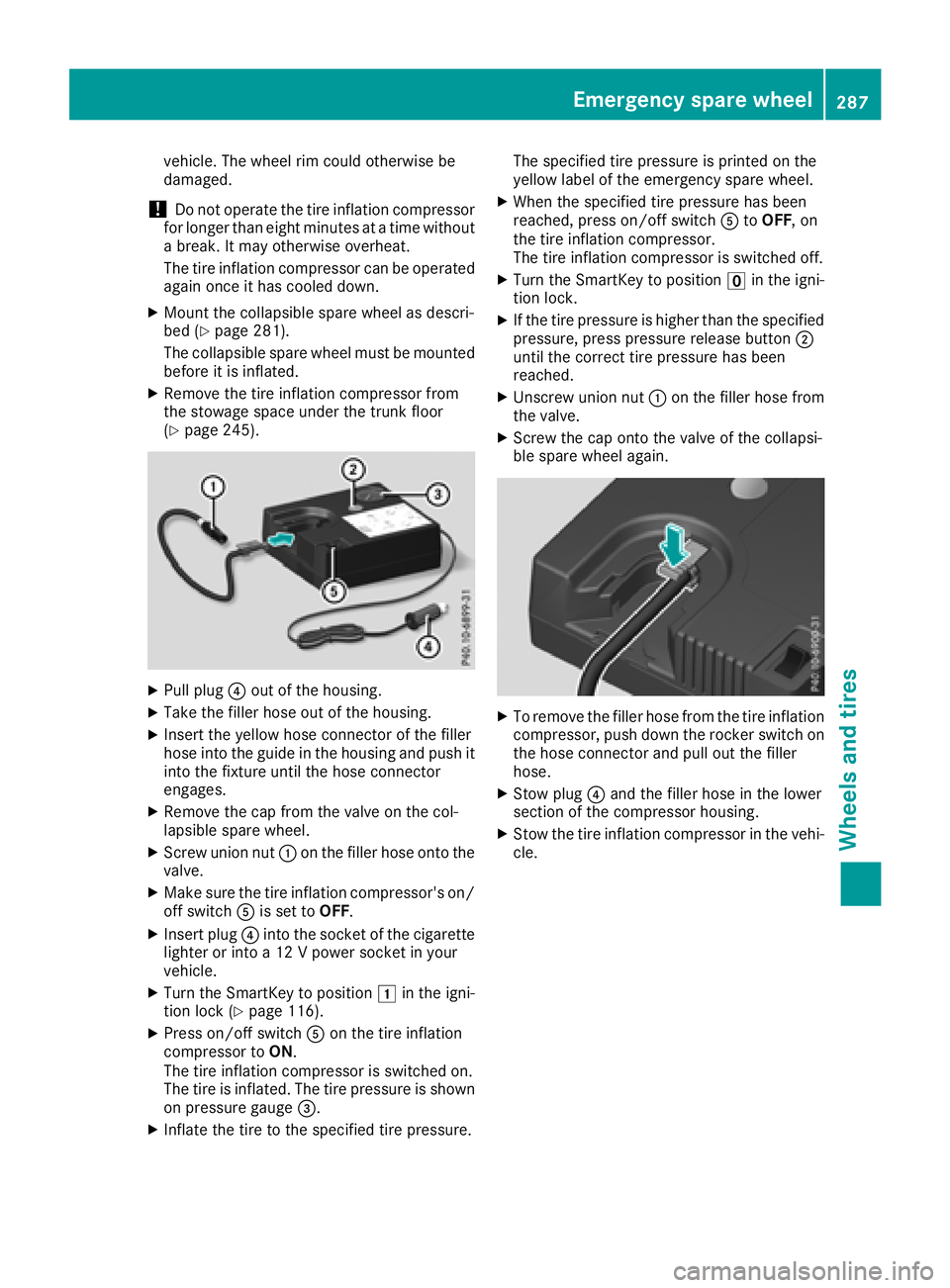
vehicle. The whee lr im could otherwise be
damaged.
! Do not operate the tire inflation compressor
for longer than eigh tm inutes at at ime without
ab reak. It may otherwise overheat.
The tire inflation compresso rc an be operated
again once it has cooled down. X
Mount the collapsible spare whee lasd escri-
bed ( Y
pag e2 81).
The collapsible spare whee lm ust be mounted
before it is inflated. X
Remove the tire inflation compresso rf rom
the stowage space under the trunk floor
( Y
pag e2 45).
X
Pul lp lug �
Page 290 of 298
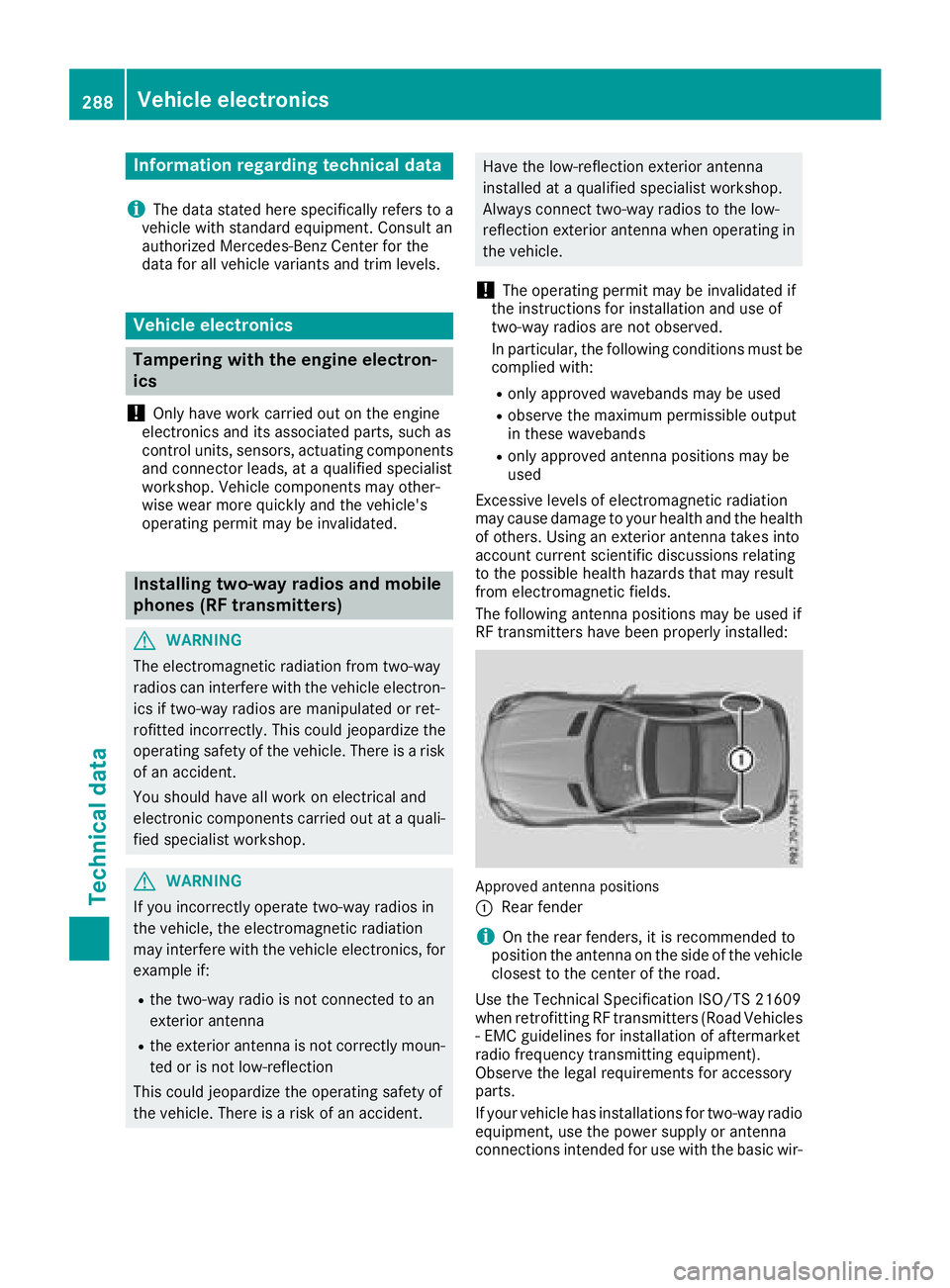
Information regardin gt echnica ld at a
i The dat as ta te dh er es pecifically refers to a
vehicl ew it hs ta ndard equipment. Consult an
authorize dM ercedes-Ben zC ente rf or th e
dat af or all vehicl ev ariants and trim levels.
Vehicle electronics
Tampering with th ee ngin ee lectron-
ics
! Only hav ew or kc arried out on th ee ng in e
electronics and it sa ssociated parts, suc ha s
control units, sensors, actuating component s
and connecto rl eads ,ataq ualified specialist
workshop. Vehicl ec om ponent sm ay other -
wise wear mor eq uickly and th ev ehicle's
operating permit may be invalidated.
Installing two-way radio sa nd mobile
phones (RF transmitters)
G WARNIN G
The electromagneti cr adiation from two-way
radios can interfere wit ht he vehicl ee lectron -
ics if two-way radios are manipulated or ret -
rofitte di ncorrectly. This could jeopardiz et he
operating safet yoft he vehicle. Ther eisar is k
of an accident.
You should hav ea ll wor kone lectrical and
electronic component sc arried out at aq uali-
fie ds pecialist workshop.
G WARNIN G
If you incorrectl yo perate two-way radios in
th ev ehicle, th ee lectromagneti cr adiation
may interfere wit ht he vehicl ee lectronics ,f or
exampl ei f:R
th et wo-way radi oisn ot connecte dtoa n
exterio ra ntennaR
th ee xter io ra ntenna is no tc orrectly moun -
te dorisn ot low-reflection
This could jeopardiz et he operating safet yo f
th ev ehicle. Ther eisar is kofana ccident. Hav et he low-reflection exterio ra ntenna
installed at aq ualified specialist workshop.
Always connec tt wo-way radios to th el ow-
reflection exterio ra ntenna when operating in
th ev ehicle.
! The operating permit may be invalidated if
th ei nstruction sf or installation and use of
two-way radios are no to bserved.
In particular, th ef ollowin gc onditi on sm ust be
complied with: R
only approve dw avebands may be used R
observ et he maximum permissible output
in these wavebands R
only approve da ntenna position sm ay be
used
Excessiv el evels of electromagneti cr adiation
may caus ed amag etoy our healt ha nd th eh ealt h
of others. Using an exterio ra ntenna takes int o
accoun tc urren ts ci entific discussion sr elating
to th ep ossible healt hh azards that may result
from electromagneti cf ields.
The followin ga ntenna position sm ay be used if
RF transmitters hav eb een properly installed:
Approved antenna position s
�C
Rear fender
i On th er ear fenders, it is recommended to
position th ea ntenna on th es ide of th ev ehicl e
closes ttot he center of th er oad .
Use th eT echnical Specification ISO/TS 2160 9
when retrofitting RF transmitters (Road Vehicles
-E MC guidelines for installation of aftermarket
radi of re quency transmitting equipment) .
Observ et he legal requirements for accessory
parts.
If your vehicl eh as installation sf or two-way radi o
equipment, use th ep ower suppl yora ntenna
connection si ntended for use wit ht he basic wir-288
Vehicle electronics
Technical data